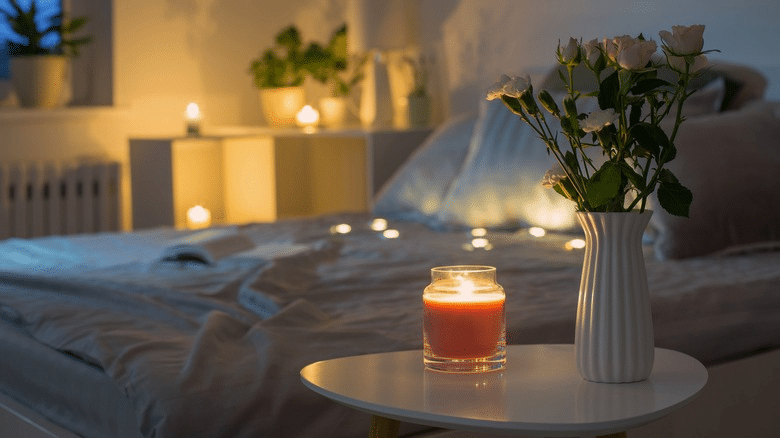That vanilla candle on your coffee table smells nice for about twenty minutes. Then, your nose gives up, and you’re back to feeling stressed, wondering why your house doesn’t feel as chill as that fancy spa you went to last year.
Most people think aromatherapy means buying whatever Bath & Body Works candle smells good and calling it a day. But there’s actually some wild science behind why certain scents make you feel genuinely calmer—and why most home setups barely scratch the surface.
Why Your Candle Game Isn’t Working
Your sense of smell adapts crazy fast. That’s why you stop noticing your favorite candle after fifteen minutes, but can immediately smell someone else’s house when you walk in. Your brain just tunes out familiar scents.
Most people pick scents because they smell nice, not because they do anything useful for stress levels. There is a big difference between something that smells good and something that calms you down.
The Science Behind Calming Scents
Smell hits differently than other senses. It goes straight to the emotional parts of your brain without stopping at the logical thinking areas first. That’s why certain scents can instantly change your mood.
What makes some scents actually work comes down to specific compounds called terpenes, found in cannabis and other plants. Lavender has linalool, which literally slows your heart rate. Citrus contains limonene that boosts happy brain chemicals. Pine releases pinene, which cuts stress hormones.
Natural aromatic compounds hit different than synthetic fragrances. Your brain processes them as actual therapeutic substances instead of just a “pleasant smell.”
Multiple Diffusion Points (Game Changer)
Forget trying to scent your whole house with one diffuser. That’s amateur hour. Advanced aromatherapy utilizes multiple scent sources, alternating between them at different times.
Set up three spots in your main living area. A fancy nebulizing diffuser near your couch runs lavender-bergamot for twenty minutes every hour. Reed diffusers by the windows provide constant woody base notes. A small diffuser in the corner releases citrus bursts during peak stress times.
Timing trick: Twenty minutes on, ten minutes off, repeat. Prevents your nose from adapting while keeping therapeutic effects going all day.
Different Rooms Need Different Vibes

Bedrooms get the sleepy stuff: chamomile, lavender, cedarwood. These contain compounds that slow down brain activity. Avoid anything energizing like peppermint or citrus after dinner.
Living areas need stress-busting combinations. Sandalwood, lavender, and a tiny bit of bergamot come together to create that “finally, I can relax” feeling when you sit down.
Home offices can handle focus-boosting scents like rosemary and peppermint, but don’t go crazy. Too much becomes distracting instead of helpful.
Your entryway sets the tone for everything. Subtle woody scents signal “safe space” to your nervous system the moment you walk in.
Equipment That Works
Most people think those basic plug-in diffusers from Target are enough. They’re not. Professional-grade equipment makes a massive difference.
Nebulizing diffusers break oils into micro-particles without heat or water, so you get the full therapeutic effect. They cost more but work way better. The sleep quality difference is noticeable within a few days.
Ultrasonic diffusers are perfect for larger spaces because they run for hours without refilling. Plus, they add humidity, which helps during winter when everything’s dry.
Reed diffusers provide constant background scenting without any electricity. Great for subtle aromatherapy in spaces where you don’t want machines running.
Training Your Brain to Relax
You can basically program your brain to relax on command using scent. Spas do this with signature blends—clients smell that specific combination and immediately feel calmer because their brain associates it with relaxation.
Pick one blend for deep relaxation stuff—meditation, reading, baths. Use it consistently while doing genuinely peaceful activities for a few weeks. Eventually, just smelling it triggers relaxation responses even during chaotic moments.
It’s like having a reset button for your nervous system that you can carry around in a little bottle.
Don’t Make These Mistakes
More essential oil isn’t better. Creating blends that are too strong gives you headaches instead of reducing stress. Professional aromatherapy uses subtle amounts that affect you without overwhelming your senses.
Running aromatherapy 24/7 stops working. Even therapeutic scents lose their punch with constant exposure. Your nose needs breaks.
Cheap oils are mostly synthetic junk that smells similar but doesn’t provide therapeutic benefits. It’s worth investing in quality oils from companies that actually test their products.
Biggest mistake: Thinking aromatherapy can fix terrible sleep habits and sky-high stress levels. Scents enhance relaxation—they can’t fix fundamental problems.
Getting Started Without Going Crazy
Pick one room first. Get that working before expanding to your whole house. Bedrooms are easiest because sleep improvements are obvious.
Match equipment to your space and lifestyle. Nebulizing diffusers for serious therapeutic effects, ultrasonic for convenience, and reed diffusers for subtle background scenting.
Pay attention to what actually works versus what just smells nice. Build your collection around scents that create noticeable mood changes.

